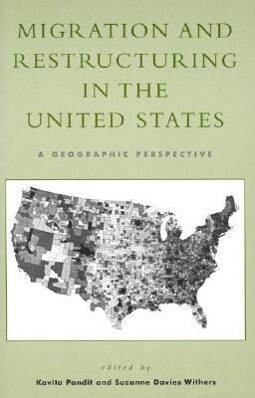
Zustellung: Mi, 30.07. - Di, 05.08.
Versand in 3-4 Wochen
VersandkostenfreiThis groundbreaking book examines the links between migration and the United States' ongoing economic and demographic revolution. Utilizing an explicitly geographic perspective, the contributors highlight the crucial role played by scale and spatial context in both immigration and internal migration.
Inhaltsverzeichnis
Chapter 1: Introduction: Geographic Perspectives on Migration and Restructuring
Section I: Migration and Economic Restructuring
Chapter 2: Migration and Persistent Poverty in Rural America
Chapter 3: Economic Restructuring and Migration in an Old Industrial Region
Chapter 4: Social and Economic Change and Intra-Metropolitan Migration
Chapter 5: Regional Outcomes of Large Scale Migration in Post Industrial America
Chapter 6: Restructuring Incentives for U.S. Immigration
Section II: Migration and Demographic Restructuring
Chapter 7: Geographic Dimensions of Aging
Chapter 8: The Geography of the Baby Boom
Chapter 9: Impacts of Immigrant Fertility on Population Size and Composition
Chapter 10: Internal Migration of Foreign-born Latinos and Asians: Are They Assimilating Geographically?
Chapter 11: Settlement Dynamics and Internal Migration of the U.S. Foreign-born Population
Chapter 12: Evolutionary Immigrant Settlement Patterns
Section III: Methodological Frontiers in Migration Research
Chapter 13: Choice Processes in Migration Behavior
Chapter 14: Life Course and Spatial Experience: A Personal Narrative Approach in Migration Studies
Chapter 15: Time Series Indicators and Physical Geography Analogies for Migration Systems
Chapter 16: Conclusion: The State of Art
Section I: Migration and Economic Restructuring
Chapter 2: Migration and Persistent Poverty in Rural America
Chapter 3: Economic Restructuring and Migration in an Old Industrial Region
Chapter 4: Social and Economic Change and Intra-Metropolitan Migration
Chapter 5: Regional Outcomes of Large Scale Migration in Post Industrial America
Chapter 6: Restructuring Incentives for U.S. Immigration
Section II: Migration and Demographic Restructuring
Chapter 7: Geographic Dimensions of Aging
Chapter 8: The Geography of the Baby Boom
Chapter 9: Impacts of Immigrant Fertility on Population Size and Composition
Chapter 10: Internal Migration of Foreign-born Latinos and Asians: Are They Assimilating Geographically?
Chapter 11: Settlement Dynamics and Internal Migration of the U.S. Foreign-born Population
Chapter 12: Evolutionary Immigrant Settlement Patterns
Section III: Methodological Frontiers in Migration Research
Chapter 13: Choice Processes in Migration Behavior
Chapter 14: Life Course and Spatial Experience: A Personal Narrative Approach in Migration Studies
Chapter 15: Time Series Indicators and Physical Geography Analogies for Migration Systems
Chapter 16: Conclusion: The State of Art
Produktdetails
Erscheinungsdatum
31. August 1999
Sprache
englisch
Seitenanzahl
368
Herausgegeben von
Suzanne Davies Withers
Verlag/Hersteller
Produktart
kartoniert
Gewicht
476 g
Größe (L/B/H)
228/149/20 mm
ISBN
9780847693931
Entdecken Sie mehr
Pressestimmen
The strength of this book lies in its wide applicability. It includes geographic analysis, but then amplifies traditional paradigms to include a mix of economic and demographic methodology and theoretical frameworks... All three sections of the book include a wealth of data and useful material, some of which is a thorough compilation and presentation of existing information, while some is more original and current research... [The book] effectively underscores and illustrates the complexities and benefits of interdisciplinary approaches in migration research. Sais Review Sixteen mostly excellent chapters on a range of topics and interrelationships, at a variety of spatial scales, are organized into three sections. Regional Studies This edited volume successfully excavates some of the complex interrelationships between migration behaviour and contemporary socio-economic restructuring in the U.S. The editors provide brief introductory and concluding chapters that help the reader to organize and digest the various themes and approaches. International Journal Of Population Geography Migration research has a long and rich history within the field of geography. This volume provides a very nice picture of the depth at which geographers have interrogated this pervasive phenomenon. The collection is a solid and coherent examination of migration within the context of changing economic and demographic structures in the 1980s and 1990s. The contributions are well connected and speak to one another creating a natural flow from one topic to another. Urban Studies It contains some excellent papers drawing on the latest research of many senior and well-respected migration experts. The book serves a very useful purpose in bringing these chapters together. Population Studies An impressive entry into the field of migration studies and economic restructuring. The book's breadth of coverage will establish it as an essential reference. The analysis is clear and effectively summarizes known and current research in this broad area. -- Stephen A. Matthews, The Pennsylvania State University
Bewertungen
0 Bewertungen
Es wurden noch keine Bewertungen abgegeben. Schreiben Sie die erste Bewertung zu "Migration and Restructuring in the United States" und helfen Sie damit anderen bei der Kaufentscheidung.







